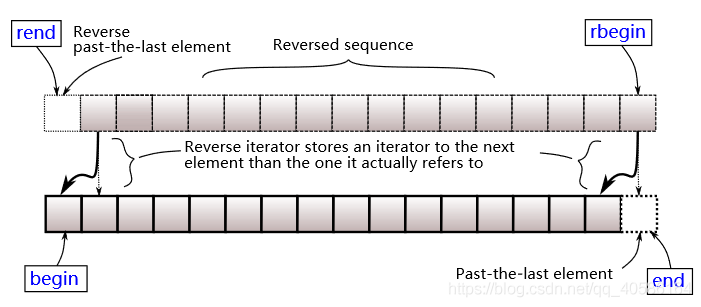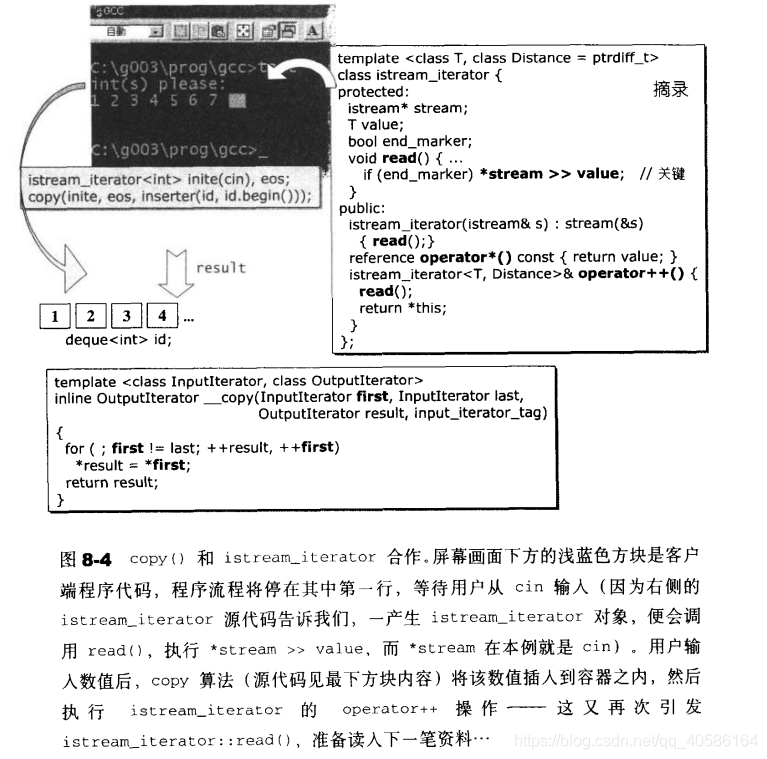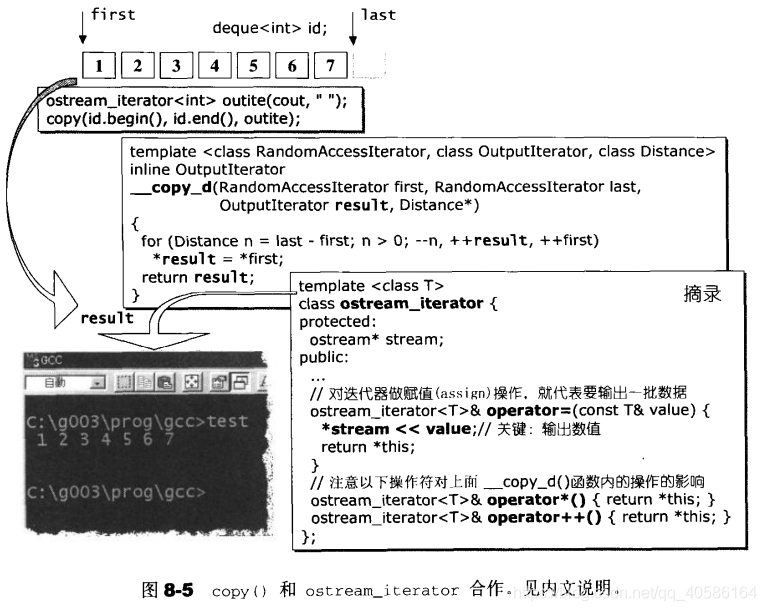C++迭代器適配器:反向迭代器、插入迭代器、iostream迭代器
適配器是標準庫中的一個通用概念。容器、迭代器和函數都有適配器(C++11出現了lambda函數、function類別範本、bind函數,幾乎取代了函數適配器)。本質上,適配器是一種機制 機製,能使某種事物的行爲看起來像另外一種一樣。棧、佇列、優先佇列都屬於容器適配器。本文主要介紹迭代器適配器。
迭代器適配器主要有三類:反向迭代器,插入迭代器,iostream迭代器。
插入迭代器
插入迭代器有三種類型,差異在於元素插入的位置:
back_inserter( Container& c ),在容器尾部插入,只能對有push_back()的容器使用inserter( Container& c, Container::iterator i ),在容器內部指定迭代器前插入,只能對有insert()的容器使用。front_inserter( Container& c ),在容器頭部插入,只能對有push_front()的容器使用。
假如你不能確定容器的大小,使用這三種迭代器,可以保證了不會造成越界的情況。
vector<int> v{1, 2, 3, 4, 5, 6, 7, 8, 9, 10};
fill_n(inserter(v, v.begin() + 1), 3, -2); // v:1 -2 -2 -2 2 3 4 5 6 7 8 9 10
vector<int> v2;
copy(v.begin(),v.end(),back_inserter(v2)); // v2:1 -2 -2 -2 2 3 4 5 6 7 8 9 10
deque<int> d;
copy(v.begin(),v.end(),front_inserter(d)); //逆序插入 d:10 9 8 7 6 5 4 3 2 -2 -2 -2 1
原理分析
每一個insert iterators 內部都維護有一個容器(必須由使用者指定);容器當然有自己的迭代器,於是,當用戶端對insert iterators做賦值(assign)操作時,就在insert iterators中被轉爲對該容器的選代器做插入操作,也就是說,在insert iterators的operator=操作符中呼叫底層容器的push_front()或push_back()或insert()操作函數。至於其它的迭代器慣常行爲如operator++,operator++(int),operator*都被關閉功能,更沒有提供operator--(int)或operator--或operator->等功能。換句話說,insert iterators的前進、後退、取值、成員取用等操作都是沒有意義的,甚至是不允許的。
下面 下麪是back_inserter原始碼:
template <class Container>
class back_insert_iterator
{
protected:
Container* container;
public:
typedef output_iterator_tag iterator_category;
typedef void value_type;
typedef void difference_type;
typedef void pointer;
typedef void reference;
explicit back_insert_iterator(Container& x) : container(&x) {}
// 只有提供了push_back()操作的容器才能 纔能使用back_insert_iterator
back_insert_iterator<Container>&
operator=(const typename Container::value_type& value)
{
container->push_back(value);
return *this;
}
back_insert_iterator<Container>& operator*() { return *this; }
back_insert_iterator<Container>& operator++() { return *this; }
back_insert_iterator<Container>& operator++(int) { return *this; }
};
反向迭代器
反向迭代器就是將迭代器的移動行爲倒轉。如果STL演算法接受的不是一般正常的迭代器,而是這種逆向迭代器,它就會以從尾到頭的方向來處理序列中的元素。例如:
//將所有元素逆向拷貝到ite所指位置上
//rbegin()和rend()返回的就是反向迭代器
copy(id.rbegin(),id.rend(),ite);
id.rbegin().base()返回反向迭代器對應的正向迭代器id.end()。
rbegin()雖然對應於原迭代器的end(),但是逆向迭代器的operator* 被過載爲將"對應的正向迭代器後退一格而後取值",因此*id.rbegin()返回容器尾部元素值。這麼做是爲了配合迭代器區間左閉右開的習慣,使其不用額外修改就能搭配原有的STL函數。

實線表示取值*時對應的迭代器,虛線表示實際對應的迭代器。
template <class Iterator>
class reverse_iterator
{
protected:
Iterator current;
public:
typedef typename iterator_traits<Iterator>::iterator_category
iterator_category;
typedef typename iterator_traits<Iterator>::value_type
value_type;
typedef typename iterator_traits<Iterator>::difference_type
difference_type;
typedef typename iterator_traits<Iterator>::pointer
pointer;
typedef typename iterator_traits<Iterator>::reference
reference;
typedef Iterator iterator_type;
typedef reverse_iterator<Iterator> self;
public:
reverse_iterator() {}
explicit reverse_iterator(iterator_type x) : current(x) {}
reverse_iterator(const self& x) : current(x.current) {}
#ifdef __STL_MEMBER_TEMPLATES
template <class Iter>
reverse_iterator(const reverse_iterator<Iter>& x) : current(x.current) {}
#endif /* __STL_MEMBER_TEMPLATES */
iterator_type base() const { return current; }
reference operator*() const {
Iterator tmp = current;
return *--tmp;
}
#ifndef __SGI_STL_NO_ARROW_OPERATOR
pointer operator->() const { return &(operator*()); }
#endif /* __SGI_STL_NO_ARROW_OPERATOR */
self& operator++() {
--current;
return *this;
}
self operator++(int) {
self tmp = *this;
--current;
return tmp;
}
self& operator--() {
++current;
return *this;
}
self operator--(int) {
self tmp = *this;
++current;
return tmp;
}
self operator+(difference_type n) const {
return self(current - n);
}
self& operator+=(difference_type n) {
current -= n;
return *this;
}
self operator-(difference_type n) const {
return self(current + n);
}
self& operator-=(difference_type n) {
current += n;
return *this;
}
reference operator[](difference_type n) const { return *(*this + n); }
};
iostream迭代器
- istream_iterator(),輸入迭代器,可以對istream物件進行操作
- ostream_iterator(),輸出迭代器,可以對ostream物件進行操作
所謂iostream迭代器,可以將迭代器系結到一個stream(數據流)物件身上。系結istream物件(例如cin)者,稱爲istream_iterator,擁有輸入能力;系結到ostream物件(例如cout)者,稱爲ostream_iterator,擁有輸出能力。
cout<<accumulate(istream_iterator<int>(cin),istream_iterator<int>(),0);//輸出從標準輸入讀取的值得和
vector<int> v{1, 2, 3, 4, 5, 6, 7, 8, 9, 10};
ostream_iterator<int> out_iter(cout," ");//第一位參數爲系結輸出流;第二位參數爲輸出分隔符,預設爲空字串
copy(v.begin(),v.end(),out_iter);//標準輸出1 2 3 4 5 6 7 8 9 10
原理分析
- istream迭代器
所謂系結一個istream object,其實就是在istream_iterator內部維護一個istream member,用戶端對於這個迭代器所做的operator++操作,會被導引呼叫迭代器內部所含的那個istream member的輸入操作(operator>>)。這個迭代器是個Input iterator,不具備operator- -。如下是可讀性比較強的一種原始碼版本。
template <class T, class Distance = ptrdiff_t>
class istream_iterator
{
friend bool
operator== __STL_NULL_TMPL_ARGS (const istream_iterator<T, Distance>& x,
const istream_iterator<T, Distance>& y);
protected:
istream* stream;
T value;
bool end_marker;//是否繼續輸入,結束爲false,繼續爲true
void read() {//讀取輸入流
end_marker = (*stream) ? true : false;
if (end_marker) *stream >> value;
end_marker = (*stream) ? true : false;
}
public:
typedef input_iterator_tag iterator_category;
typedef T value_type;
typedef Distance difference_type;
typedef const T* pointer;
typedef const T& reference;
istream_iterator() : stream(&cin), end_marker(false) {}//使用預設構造時,讀取標記關閉,不再讀取,相當於eof
istream_iterator(istream& s) : stream(&s) { read(); }//系結時已開始讀取
reference operator*() const { return value; } //返回輸入的數據
#ifndef __SGI_STL_NO_ARROW_OPERATOR
pointer operator->() const { return &(operator*()); }
#endif /* __SGI_STL_NO_ARROW_OPERATOR */
istream_iterator<T, Distance>& operator++() {
read();
return *this;
}
istream_iterator<T, Distance> operator++(int) {
istream_iterator<T, Distance> tmp = *this;
read();
return tmp;
}
};

- ostream迭代器
所謂系結一個ostream object,就是在其內部維護一個ostream member,用戶端對於這個迭代器所做的 operator=操作,會被導引呼叫對應的(迭代器內部所含的)那個ostream member的輸出操作(operator<<).這個迭代器是個Oufputterator.下面 下麪的原始碼和註釋說明了一切。
至於ostream iterator,所謂系結一個ostream object,就是在其內部維護一個ostream member,用戶端對於這個迭代器所做的 operator=操作,會被導引呼叫對應的(迭代器內部所含的)那個ostream member的輸出操作(operator<<)。這個迭代器是個Output iterator。
template <class T>
class ostream_iterator
{
protected:
ostream* stream;
const char* string;
public:
typedef output_iterator_tag iterator_category;
typedef void value_type;
typedef void difference_type;
typedef void pointer;
typedef void reference;
ostream_iterator(ostream& s) : stream(&s), string(0) {}
ostream_iterator(ostream& s, const char* c) : stream(&s), string(c) {}
ostream_iterator<T>& operator=(const T& value) {
*stream << value;
if (string) *stream << string;
return *this;
}
ostream_iterator<T>& operator*() { return *this; }
ostream_iterator<T>& operator++() { return *this; }
ostream_iterator<T>& operator++(int) { return *this; }
};

參考:
《STL原始碼剖析》